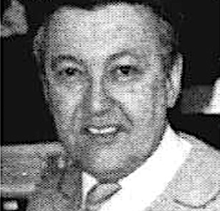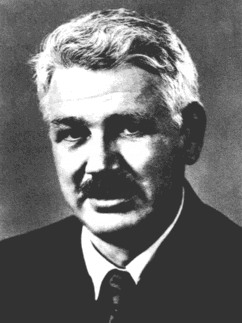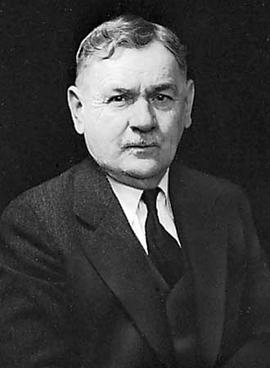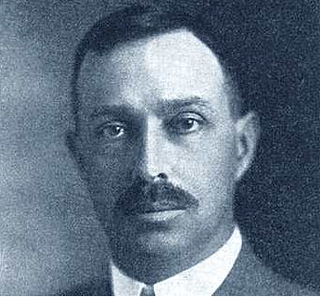Vladimir Markotic | |
|---|---|
 | |
| Born | July 16, 1920 |
| Died | November 1994 |
| Occupation | Anthropologist |
Vladimir Markotic (July 16, 1920 - November 1994) was a Croatian-American anthropologist, archaeologist and cryptozoologist.
Vladimir Markotic | |
|---|---|
 | |
| Born | July 16, 1920 |
| Died | November 1994 |
| Occupation | Anthropologist |
Vladimir Markotic (July 16, 1920 - November 1994) was a Croatian-American anthropologist, archaeologist and cryptozoologist.
Markotic was born in Banja Luka. [1] He emigrated to the United States in 1947. He obtained his M.A. Anthropology from Indiana University (1955) and a PhD in anthropology from Harvard University (1963). [1] He was a research assistant at Indiana University and a teaching assistant for the Institute of East European Studies. Markotic was a Fellow of the Peabody Museum of Archaeology and Ethnology at Harvard University and a Fellow of the American Anthropological Association. [1]
In 1962, he became assistant professor of archaeology at Illinois State University and from 1969 was associate professor of archaeology at University of Calgary. He retired as Associate Professor Emeritus in 1986. He was a specialist in Old World Archaeology and took interest in the ethnology and linguistics pertaining to Bosnia and Croatia. [1] Markotic died in Calgary, aged 74. [1]
Markotic took interest in bigfoot and was a researcher in the field of cryptozoology, which has been criticized as pseudoscience. In 1984, he contributed a chapter to the book The Sasquatch and Other Unknown Hominoids, which he also edited with Grover Krantz. The book consists of 21 papers by a multitude of authors. It was negatively reviewed by Michael R. Dennett in the Skeptical Inquirer . [2] Dennett commented that "The Sasquatch and Other Unknown Hominoids is bad science and, taken as a whole, bad writing... Until some real evidence comes to light there is no reason for anyone to take Sasquatch promoters seriously, especially if this book represents their best effort." [2]
Anthropologist Kathleen J. Reichs wrote that the book failed to provide a scientifically rigour analysis of the physical evidence for unknown hominoids and is "riddled throughout with typographical and grammatical errors." [3] She concluded that the book is unsatisfying from the point of view of physical anthropology but is worth reading for providing insight into non-mainstream interpretations of hominid evolution. [3]
Biologist Debra A. Oleksiak commented that apart from a few exceptions "there is no critical evaluation of the sources and the accuracy of the data" and noted that many of the papers in the book "do not reflect an understanding of biological processes or evolutionary thinking". [4]

Anthropology is the scientific study of humanity, concerned with human behavior, human biology, cultures, societies, and linguistics, in both the present and past, including past human species. Social anthropology studies patterns of behavior, while cultural anthropology studies cultural meaning, including norms and values. A portmanteau term sociocultural anthropology is commonly used today. Linguistic anthropology studies how language influences social life. Biological or physical anthropology studies the biological development of humans.

Bigfoot, also commonly referred to as Sasquatch, is a large and hairy human-like mythical creature purported to inhabit forests in North America, particularly in the Pacific Northwest.

The Patterson–Gimlin film is an American short motion picture of an unidentified subject that the filmmakers have said was a Bigfoot. The footage was shot in 1967 in Northern California, and has since been subjected to many attempts to authenticate or debunk it.

Carleton Stevens Coon was an American anthropologist. A professor of anthropology at the University of Pennsylvania, lecturer and professor at Harvard University, he was president of the American Association of Physical Anthropologists. Coon's theories on race were widely disputed in his lifetime and are considered pseudoscientific in modern anthropology.

Clark David Wissler was an American anthropologist, ethnologist, and archaeologist.
Grover Sanders Krantz was an American anthropologist and cryptozoologist; he was one of few scientists not only to research Bigfoot, but also to express his belief in the animal's existence. Throughout his professional career, Krantz authored more than 60 academic articles and 10 books on human evolution, and conducted field research in Europe, China, and Java. He was a member of Mensa and Intertel, high-IQ societies.
The Skookum cast is a plaster cast showing the imprint of what appears to be a large animal’s left forearm, hip, thigh and buttocks. It was discovered in a muddy wallow near Mount Adams in the southern part of Washington state in the year 2000 and is argued by some to have been made by a Bigfoot.
Roderick Sprague III was an American anthropologist, ethnohistorian and historical archaeologist, and the Emeritus Director of the Laboratory of Anthropology at the University of Idaho in Moscow, where he taught for thirty years. He had extensive experience in environmental impact research, trade beads, aboriginal burial customs, and the Columbia Basin area. Sprague was president of the Society of Bead Researchers from 2004-2007.

Kathleen Joan Reichs is an American crime writer, forensic anthropologist and academic.She is an adjunct professor of anthropology at the University of North Carolina at Charlotte. She is well known for inspiring the television series Bones.

Sasquatch: Legend Meets Science is a documentary television film written and directed by Minnesota-based wildlife researcher and film producer Doug Hajicek. The program originally aired on the Discovery Channel on January 9, 2003 and features scientists from various disciplines analyzing evidence for the existence of Bigfoot, including the 1967 Patterson–Gimlin film, the 1996 Memorial Day Bigfoot footage, and the 2000 Skookum cast.
Don Jeffrey "Jeff" Meldrum is a Full Professor of Anatomy and Anthropology in the Department of Biological Sciences at Idaho State University. Meldrum is also Adjunct Professor in the Department of Physical and Occupational Therapy and the Department of Anthropology. Meldrum is an expert on foot morphology and locomotion in primates.

Roland Burrage Dixon was an American anthropologist.

Edward M. Bruner was professor emeritus of anthropology and criticism and interpretive theory at the University of Illinois at Urbana-Champaign. He was an American anthropologist known for his contributions to the anthropology of tourism, particularly his constructivist, processual approach that centers on experience and narrative in and beyond tourist settings. His book Culture on Tour: Ethnographies of Travel is perhaps his best-known book. He has written numerous articles on tourism and has edited or coedited four volumes, including International Tourism: Identity and Change. His early field research was on acculturation and culture chance in Native North American communities in the 1950s. Subsequently, he studied Toba Batak migrants in Indonesia in the 1960s, then turned his attention to performance, narrative, and tourism in the 1980s through the present.
Michael Edward Moseley is an American anthropologist at the University of Florida.
Leslie Spier was an American anthropologist best known for his ethnographic studies of American Indians. He spent a great deal of his professional life as a teacher; he retired in 1955 and died in 1961.
The Jacko hoax was a Canadian newspaper story about a gorilla supposedly caught near Yale, British Columbia in 1884. The story, titled "What is it?, A strange creature captured above Yale. A British Columbia Gorilla", appeared in the British Columbia newspaper the Daily Colonist on July 4, 1884. The original newspaper article describes "Jacko" as a gorilla and not a Sasquatch. However, the "Jacko" story has been used by Bigfoot advocates as evidence for the existence of Sasquatch. Many books about Bigfoot and cryptids have featured the event and cite the original newspaper article. In 2008 Michael Cremo discussed the story as possible proof for the existence of Sasquatch. The "Jacko" story was featured on the A&E television documentary series Ancient Mysteries about Bigfoot, season 4, episode 18 narrated by Leonard Nimoy. The story was also mentioned on the Bigfoot episode of the television series In Search Of..., season 1, episode 5, also narrated by Nimoy. The Jacko story was mentioned in a 1976 documentary called The Mysterious Monsters.
Brian Regal is an American historian of science, skeptic and writer. He is an associate professor of the history of science at Kean University in New Jersey.
Bertha Pauline Dutton was an American anthropologist and ethnologist specializing in the American Southwest and Mesoamerica. She was one of the first female archeologists to work with the National Park Service.
Dorothy L. Keur was an American cultural anthropologist specializing in Navajo and Netherlands cultures. She was a professor at Hunter College and was the president of the American Ethnological Society from 1974 to 1979.